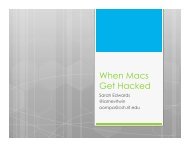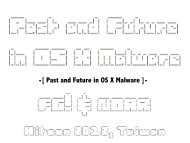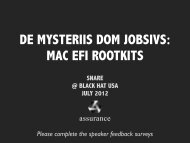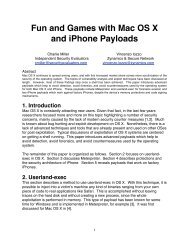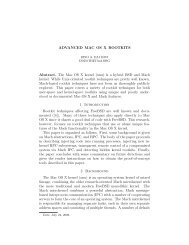Down the Rabbit Hole - Reverse Engineering Mac OS X
Down the Rabbit Hole - Reverse Engineering Mac OS X
Down the Rabbit Hole - Reverse Engineering Mac OS X
Create successful ePaper yourself
Turn your PDF publications into a flip-book with our unique Google optimized e-Paper software.
Dynamically Overriding <strong>Mac</strong> <strong>OS</strong> X<strong>Down</strong> <strong>the</strong> <strong>Rabbit</strong> <strong>Hole</strong>Jonathan ‘Wolf’ Rentzschhttp://rentzsch.comMonday, February 9, 2009
“These rules are no different thanthose of a computer system.Some of <strong>the</strong>m can be bent.O<strong>the</strong>rs... can be broken.”—MorpheusMonday, February 9, 2009
What Happened toHow to Hack <strong>Mac</strong> <strong>OS</strong> X?The paper’s original title was “How to Hack <strong>Mac</strong> <strong>OS</strong> X”However, “hacking” is just too abused, especially in <strong>the</strong>Unix realm.Really, think “trap patching”. However:On <strong>Mac</strong> <strong>OS</strong> X, traps aren’t used nearly as often.“Patching” also has a specific definition in <strong>the</strong> Unixrealm: applying textual differences to source code.Thus, “dynamic overriding”.Monday, February 9, 2009
Dynamic Overriding:Made possible by twotechniques that worktoge<strong>the</strong>rFunctionOverridingCodeInjectionMonday, February 9, 2009
Function OverridingIdeally, overriding a system function would be simple:Discover <strong>the</strong> function’s entry in a universal table.Save off a pointer to <strong>the</strong> original code.Replace it with a pointer to your overriding code.Alas, <strong>Mac</strong>h’s linking model lacks any sort of centralizedbottleneck. This stands in contrast to CFM.Monday, February 9, 2009
CFM’s ModelExporter-Owned Vector Table (i.e. CFM)App Moduleimplementation blockSystem Moduleimplementation blockloadPluginsmainfreecallocvector table (import)mallocmainloadPluginsmallocPlugin Moduleimplementation blockvector table (export)malloccallocfreemainvector table (import)mainmallocMonday, February 9, 2009
CFM vs <strong>Mac</strong>hExporter-Owned Vector Table (i.e. CFM)App Moduleimplementation blockSystem Moduleimplementation blockImporter-Owned Vector Table (i.e. <strong>Mac</strong>h)App Moduleimplementation blockloadPluginsfreeloadPluginsmaincallocmainSystem Moduleimplementation blockvector table (import)mallocvector table (import)freemainloadPluginsmallocvector table (export)mallocmainloadPluginsmalloccallocmallocPlugin Moduleimplementation blockcallocfreePlugin Moduleimplementation blockvector table (export)mainmainmalloccallocfreevector table (import)vector table (import)mainmainmallocmallocMonday, February 9, 2009
Function OverridingYou may think that you could walk all loaded modulesto discover and rewrite all <strong>the</strong>ir vector tables.That won’t work:Lazy binding means symbols aren’t resolved until<strong>the</strong>y’re first used. You’d have to force resolving of allsymbols before rewriting: expensive and tricky.All <strong>the</strong> work needs to be done again when a newmodule is loaded.Won’t work for symbols looked up programatically.Monday, February 9, 2009
Function OverridingWhat will work: rewrite <strong>the</strong> original functionimplementation, in memory, itself.Basic premise: replace <strong>the</strong> original function’s firstinstruction with a branch instruction to <strong>the</strong> desiredoverride code.This technique is known as single-instructionoverwriting.You may shudder now...Monday, February 9, 2009
Single-Instruction OverwritingBenefits:Atomic replacement. Safe in <strong>the</strong> face of multiplepreemptive threads calling <strong>the</strong> original function.Less likely to harmfully impact <strong>the</strong> original code. If youwish to reenter <strong>the</strong> original function from <strong>the</strong>override, you’ll need to re-execute <strong>the</strong> replacedinstruction. Moving less code around makes thismore likely to work.Compatibility. Works with <strong>the</strong> widest variety offunction prologs and o<strong>the</strong>r patchingimplementations (including our own!)Monday, February 9, 2009
Single-Instruction OverwritingReplacing a single instruction is good, but limiting.Can’t branch to an arbitrary address, as that wouldtake at least three instructions.Leaves us with branch instructions that encode <strong>the</strong>irtargets:b (branch relative)ba (branch absolute)bl (branch relative, update link register)bla (branch absolute, update link regiter)Monday, February 9, 2009
Single-Instruction Overwritingbl and bla go away since <strong>the</strong>y stomp on <strong>the</strong> linkregister — that houses <strong>the</strong> caller’s return address!b and ba embed a 4-byte-aligned, 24-bit address.For b, that’s ±32MB relative to <strong>the</strong> current programcounter. We really can’t guarantee our override willbe within 32MB of <strong>the</strong> original function.For ba, that’s <strong>the</strong> lowermost and uppermost 32MB of<strong>the</strong> current address space. The lowermost 32MBtends to be busy with loaded code and data.That leaves ba’s uppermost 32MB of address space.Monday, February 9, 2009
The Branch IslandWe can allocate a single page at <strong>the</strong> end of <strong>the</strong>address space to hold our branch island.(<strong>Mac</strong>h’s sparse memory model works nicely here.)The branch island acts as a level of indirection,allowing <strong>the</strong> address-limited ba to effectively targetany address.Two uses for branch islands: escape and reentry.Monday, February 9, 2009
Branch IslandsEscape branch island (required):Used to jump from <strong>the</strong> original function to <strong>the</strong>overriding function.Allocated at <strong>the</strong> end of <strong>the</strong> address space.What our generated ba instruction points at.Reentry branch island:Optional, only generated if you wish to reenter <strong>the</strong>original function.Houses <strong>the</strong> original function’s first instruction.Monday, February 9, 2009
Inside <strong>the</strong> Branch IslandC definition:long kIslandTemplate[] = {0x9001FFFC,0x3C00DEAD,0x6000BEEF,0x7C0903A6,0x8001FFFC,0x60000000,0x4E800420};What, you guys don’t read machine language?!?Monday, February 9, 2009
Lame Override Animation! Escape Island Allocatedand TargetedmyMallocescape islandmallocmalloc clientMonday, February 9, 2009
Lame Override Animation! Reentry Island Allocated,Targeted & Engagedreentry islandmyMallocescape islandmallocmalloc clientMonday, February 9, 2009
Lame Override Animation! Escape Island AtomicallyEngagedreentry islandmyMallocescape islandmallocmalloc clientMonday, February 9, 2009
Function Overriding DetailsDiscover <strong>the</strong> function’s address. Use_dyld_lookup_and_bind[with_hint]()and NSIsSymbolNameDefined[WithHint]().Test <strong>the</strong> waters. Watch out for functions that start with<strong>the</strong> mfctr instruction.Make <strong>the</strong> original function writable. vm_protect().Allocate <strong>the</strong> escape island. Use vm_allocate().Target <strong>the</strong> escape island and make it executable. Usemsync().Monday, February 9, 2009
Function Overriding DetailsBuild <strong>the</strong> branch instruction. Target <strong>the</strong> escape island.Optionally allocate and engage <strong>the</strong> reentry island.Atomically:Insert <strong>the</strong> original function’s first instruction into <strong>the</strong>reentry island. If reentry is desired.Target <strong>the</strong> reentry island and make it executable. Again,if reentry is desired.Swap <strong>the</strong> original function’s first instruction with <strong>the</strong>generated ba instruction. If atomic replacement fails(unlikely), loop and try again.Monday, February 9, 2009
Code Injection OverviewFunction overriding is a powerful technique, but it’sonly attains half of our goal.By itself, we can only override system functions in ourown software.Code injection, on <strong>the</strong> o<strong>the</strong>r hand, allows us overrideapplication and system functions in any process.Not just override functions, but inject new ObjectiveC classes (example: for posing)Monday, February 9, 2009
Code Injection Overview<strong>Mac</strong>h supplies everything we need.It’s just not very well documented. ; )Specifically, <strong>Mac</strong>h provides APIs for:Remote memory allocation. (vm_allocate())Remote memory I/O. (vm_write())Remote thread allocation. (thread_create())Remote thread control.(thread_create_running())Monday, February 9, 2009
Code Injection DetailsAllocate a remote thread stack. No need to populate it— parameters will be passed in registers.Allocate and populate <strong>the</strong> thread’s code block. The gotchahere is determining <strong>the</strong> thread entry’s code size. It’ssurprisingly hard, and requires a calling <strong>the</strong> dynamicloader APIs and stat()’ing <strong>the</strong> file system!Allocate, populate and start <strong>the</strong> thread. Set <strong>the</strong> threadcontrol block’s srr0 to <strong>the</strong> code block, r1 to <strong>the</strong>stack, r3 through r10 to parameters and lr to0xDEADBEEF (this thread should never return).Monday, February 9, 2009
Code Injection LeakageWhile <strong>the</strong> injected thread can stop itself, it can’tdelete itself (it would need to deallocate its own stackand code while running).May be work-arounds, like <strong>the</strong> injected threadspawning ano<strong>the</strong>r “normal” cleanup thread.Ano<strong>the</strong>r solution is to install a permanent “injectionmanager” thread, that would start a <strong>Mac</strong>h server tohandle future injections via IPC.Bonus feature: such an “injection server” wouldeliminate <strong>the</strong> need to start a new thread perinjection.Monday, February 9, 2009
Code & Doc AvailabilityTwo packages, both written in C:mach_override: Implements function overriding.http://rentzsch.com/mach_overridemach_inject: Implements code injection.http://rentzsch.com/mach_injectCode is hosted by Extendamac (BSD-style license)http://extendamac.sourceforge.netMonday, February 9, 2009
Conclusion“Whoa.”—NeoMonday, February 9, 2009





